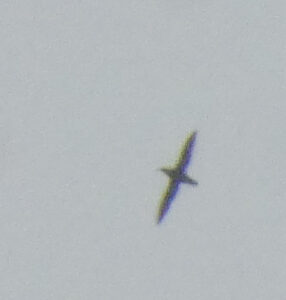Bird Notes by Jim Cassels
Sooty shearwaters breed across the cold-water areas of the southern oceans from southern South America and the Falkland Islands to Australia, Tasmania and New Zealand, where the largest colonies occur.
The world population has been estimated at 20 million birds.
After breeding, sooty shearwaters make a huge clockwise migration into the North Atlantic and North Pacific Oceans. Travelling vast distances in their lifetime, sooty shearwaters hold the record for the longest animal migration recorded electronically, an astounding 40,000 miles in 200 days.
Around Scotland, sooty shearwater is a regular passage seabird recorded at coastal locations, usually from late summer to late autumn with most passage in August and September. On Arran there have only been eight records since 1980. The largest number was six in 2008 and the last record in 2009.
On Friday August 11 2023, James Morrison, aged 15, checked the weather forecast and with the winds switching to southerly decided to try his luck seawatching across Machrie Bay.
He said: “I arrived on site around 3pm and got myself set up and immediately picked up a Great-northern Diver going south. Shortly after this, I picked up two distant Manx shearwaters also going south. Over the next hour or so, I’d only had another eight Manx shears, all moving south. Things were a tad slower than I hoped for but decided to stick it out for a bit longer and I’m glad I did.
“Around 3.45pm I picked up a shearwater going south. It was flying completely different to any Manx shearwater I have ever seen. It was moving very fast and flying in big arcs, almost loop to loop. It would fly up really high, then swoop down to the water surface without flapping its wings once and it continued to do this for the entire two minutes or so that I observed it. I knew this bird was definitely not a Manx as it actually outstripped one as I watched it sail past, giving a good comparison between the two birds.”
James quickly grabbed his camera and got a record shot of the shearwater before it moved out of range. While it was not an award-winning photograph, it showed the key features, all dark in appearance – long narrow pointed wings, long necked, an almost cigar shaped body and short tailed.
Sooty shearwater is a rare bird and to have this record ratified, James completed the rare birds record form and submitted it to the Clyde Birds Rarities Panel. His submission included a photograph of the shearwater and photographs of Manx shearwaters for comparison.
The record was unanimously accepted by the panel. The panel was impressed by the standard of submission and his remarkable ability to get a photograph under the circumstances.
Enjoy your birding.
Please send any bird notes with “what, when, where” to me at Kilpatrick Kennels, Kilpatrick, Blackwaterfoot, KA27 8EY, or email me at jim@arranbirding.co.uk. I look forward to hearing from you. For more information on birding on Arran buy the Arran Bird Report 2022 and visit the website http://www.arranbirding.co.uk/index.html

This photograph, taken by James Morrison in challenging circumstances on August 11, helped convince the rarities committee of the veracity of his report. NO_B40bird01_23_sooty_shearwater
File picture of a Sooty shearwater in flight. Photograph: Dennis Morrison. NO_B40bird02_23_rarity_committee